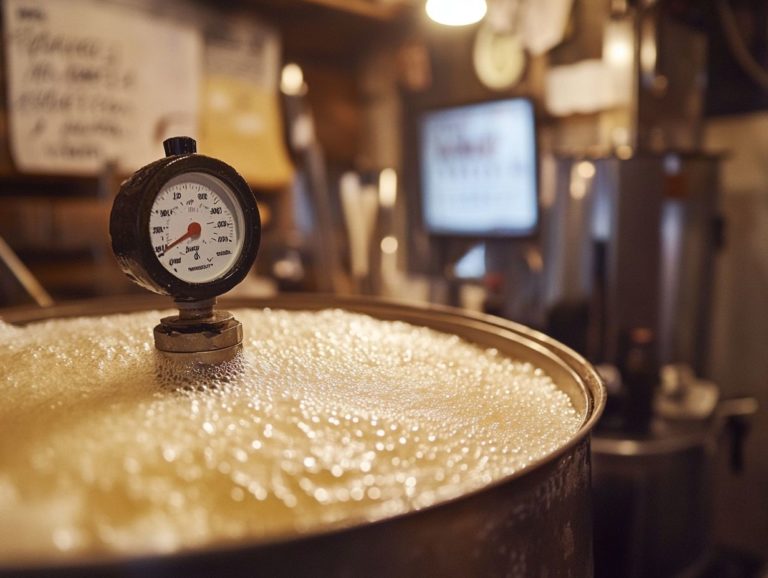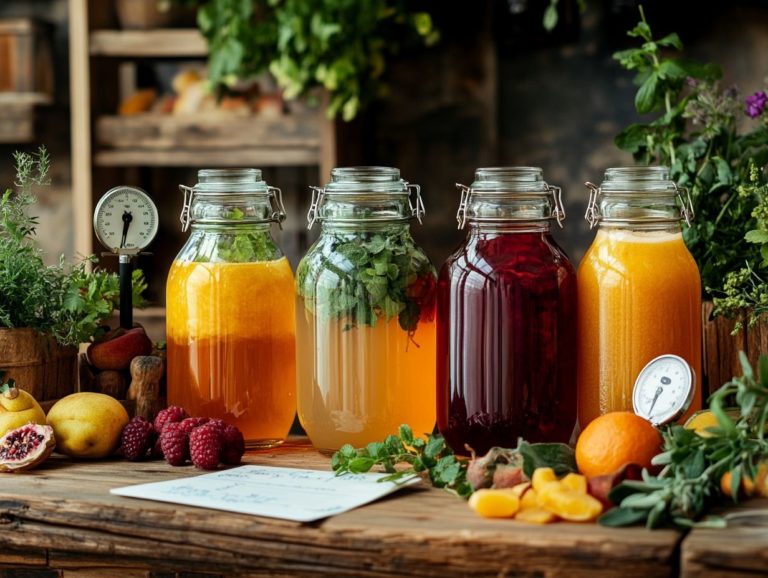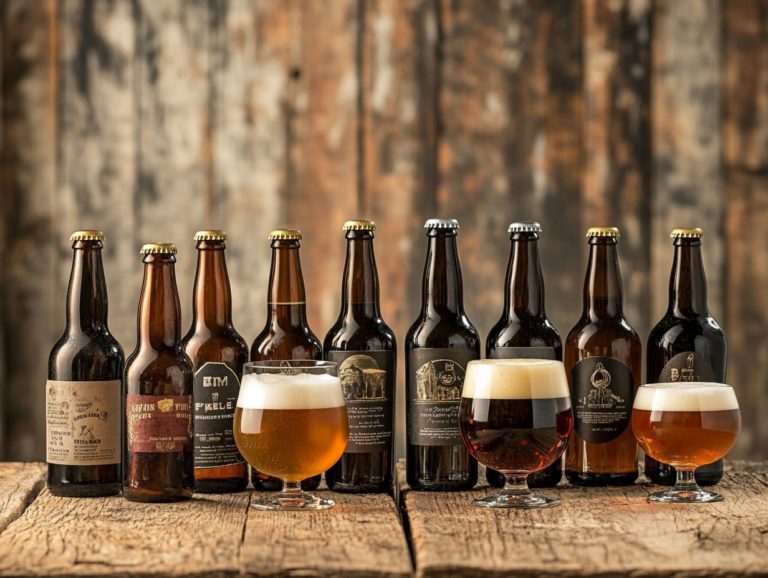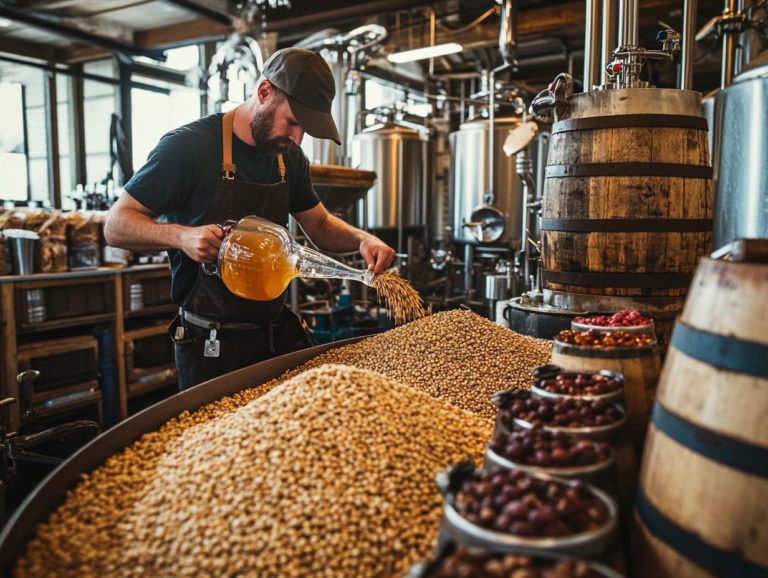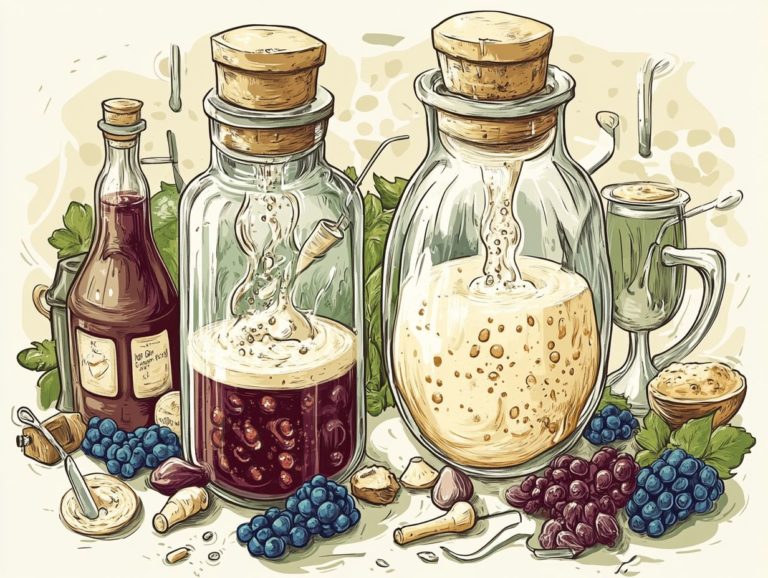Fermentation: The Heart of Home Brewing
Fermentation is an exciting process that turns sugars into alcohol and carbon dioxide, thanks to yeast, especially Saccharomyces cerevisiae. In the realm of home brewing, it plays a pivotal role in shaping flavor, aroma, and overall character.
This guide delves into the essential elements of fermentation, from choosing the perfect yeast to grasping the various factors like temperature control and oxygen levels that influence the process.
Whether you re just starting your brewing journey or seeking to hone your skills, you ll discover the crucial steps and common challenges of fermentation, including primary fermentation and pitch rates, that can truly elevate your brewing experience.
Contents
- Understanding Fermentation
- Why is Fermentation Important in Home Brewing?
- What Are the Basic Steps of Fermentation in Home Brewing?
- Brewing with Yeast: A Comprehensive Guide
- What Are the Different Types of Fermentation Used in Home Brewing?
- What Are the Factors That Affect Fermentation in Home Brewing?
- 2. Oxygen Levels
- 3. pH Levels
- 4. Sugar Content
- How Can You Tell When Fermentation is Complete?
- What Are Some Common Problems That Can Occur During Fermentation?
- Frequently Asked Questions
- What is fermentation and why is it important in home brewing?
- What type of yeast is used in home brewing fermentation?
- How long does fermentation typically take in home brewing?
- Can I control the flavor of my beer through fermentation?
- Do I need any special equipment for fermentation in home brewing?
- Is it necessary to transfer the beer during fermentation?
Key Takeaways:
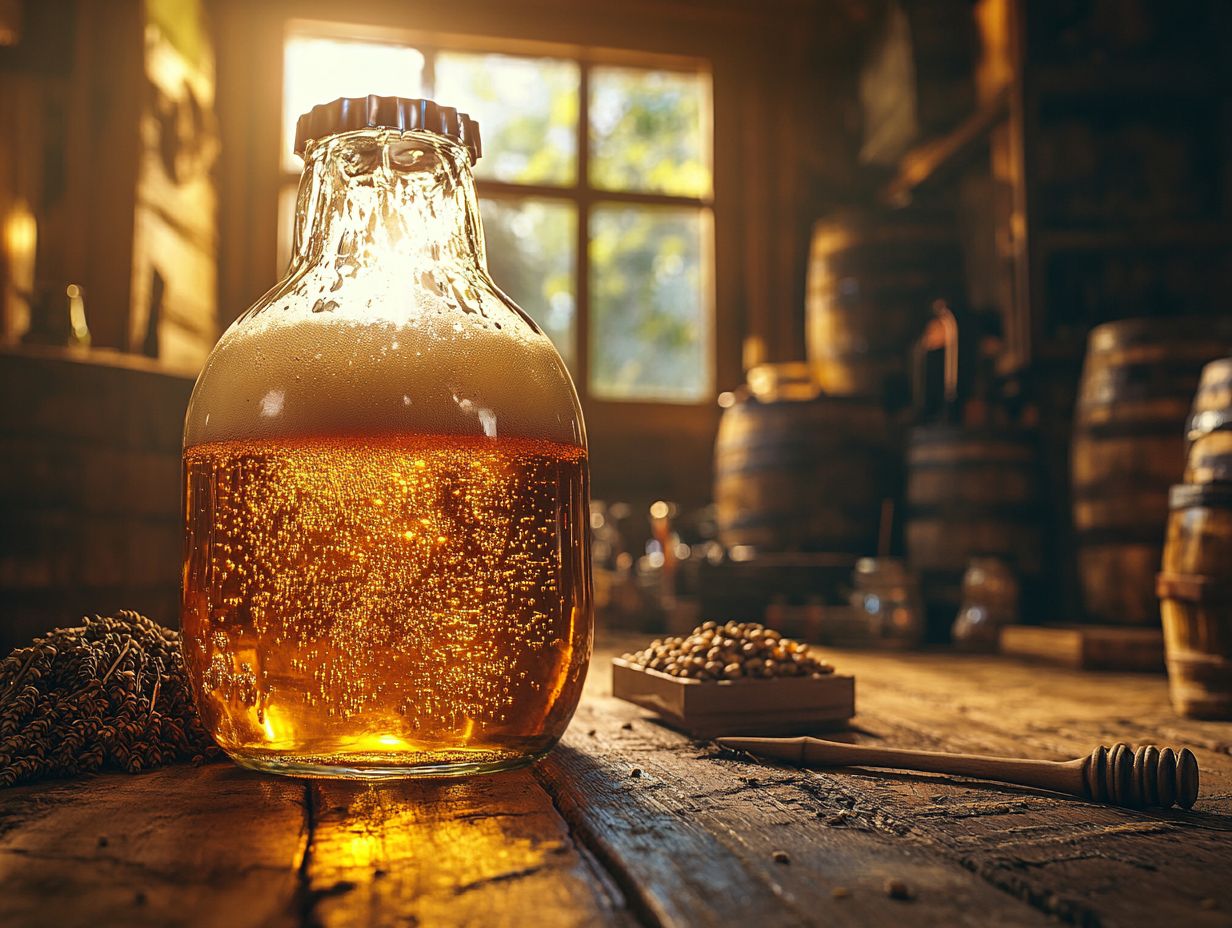
- Fermentation is the process by which yeast turns sugar into alcohol and carbon dioxide (a gas), making it a crucial step in home brewing.
- The basic steps of fermentation in home brewing include choosing the right yeast, creating a starter culture, adding yeast to the wort, controlling temperature, and monitoring the process.
- Temperature, oxygen levels, pH levels, and sugar content are all factors that can affect fermentation in home brewing, so it’s important to carefully monitor and adjust these variables during the process using proper brewing equipment.
Understanding Fermentation
Fermentation is a fascinating biochemical process that transforms sugars into alcohol and carbon dioxide, primarily driven by yeast. This essential process underpins the production of an array of alcoholic beverages, including beer, wine, and spirits. Historical figures like Louis Pasteur and Emil Hansen have significantly contributed to our understanding of this process.
Here, yeast consumes the sugars found in the wort, converting them into alcohol and crafting the complex flavor compounds that define each drink’s unique character. Understanding the nuances of fermentation is crucial for you as a brewer, as it directly impacts the final taste and quality of your beverage.
Fermentation is essential for anyone serious about brewing, influencing both the process and outcome.
Why is Fermentation Important in Home Brewing?
Fermentation stands as a pivotal stage in the home brewing journey, defining the quality, flavor, and overall essence of your final creation.
During this phase, you harness the power of yeast to transform sugars extracted from malt into alcohol, unlocking a myriad of brewing styles from robust ales to crisp lagers each highlighting the remarkable diversity achievable through various fermentation techniques.
By meticulously managing your yeast, including keeping a close eye on yeast health and pitch rates, you can profoundly influence the fermentation dynamics. Mastering fermentation unlocks endless possibilities in your brewing adventure.
What Are the Basic Steps of Fermentation in Home Brewing?
Fermentation in home brewing involves key steps to effectively turn wort into beer.
First, you must cultivate a healthy and vigorous yeast culture, as this will be instrumental in the fermentation process. After preparing the wort, controlling the fermentation temperature becomes paramount, as it significantly influences yeast activity and flavor development.
Proper temperature control is vital to achieving optimal results. Throughout the fermentation journey, regular monitoring is essential, enabling you to make necessary adjustments and ensure optimal yeast performance with the use of yeast nutrients, ultimately leading to the beverage you desire.
Brewing with Yeast: A Comprehensive Guide
1. Choosing the Right Yeast Strain
Choosing the right yeast strain is crucial for shaping the flavor and characteristics of your finished beer. Each strain brings its own unique flavor compounds and ferments at different temperatures. You need to understand the specific fermentation dynamics of each yeast strain, including its ability to ferment various sugars like maltose. Additionally, grasp how it contributes to the overall profile of ales or lagers.
Consider factors such as yeast health, the amount of yeast to add, and your desired outcome for the brew to guide this vital decision.
The yeast strain you select can greatly influence the aroma and taste of your beer. It can also affect the mouthfeel and clarity of your final product. For instance, ale yeast is renowned for its robust fermentation capabilities. It can produce esters and phenols that add layers of complexity to the flavor, making it perfect for styles like IPAs and stouts.
In contrast, lager yeast ferments at cooler temperatures, yielding a cleaner, crisper flavor that shines in styles such as pilsners.
By understanding the interactions between different yeast strains and the sugars they metabolize, you can achieve distinct flavor profiles and maintain consistent quality across your brewing batches. For example, use Hefeweizen yeast specifically for brewing wheat beers like hefeweizen, or Kveik yeast for unique farmhouse ales.
2. Creating a Starter Culture
Creating a starter culture is all about propagating yeast cells to cultivate a robust and healthy population for fermentation. This is an essential step for a successful brewing experience. This practice enhances the health of the yeast and boosts fermentation efficiency. It allows for optimal alcohol production and the development of rich flavors in your beer.
A well-prepared starter culture helps you achieve the desired pitch rate, reducing the risk of off-flavors or fermentation hiccups.
To get started, combine dried or liquid yeast with a small amount of malt extract and water. This creates an environment that’s bursting with nutrients. Once you’ve mixed it all together, aerate the mixture to encourage vigorous yeast growth and fermentation activity.
Temperature monitoring is crucial during this process. Keeping it within an optimal range is key to supporting yeast vitality. Stir the mixture regularly to evenly distribute nutrients and ensure consistent growth.
By dedicating time to develop a strong starter culture, you significantly increase your chances of producing compelling and consistent brews that beautifully showcase the intended flavor profiles.
3. Adding the Yeast to the Wort
Adding yeast to the wort is an exciting moment in your brewing journey. It signifies the transition from preparation to fermentation. It s essential to introduce the yeast at just the right time and under optimal conditions. This ensures that the yeast culture can effectively kick off its transformation of sugars in the wort into alcohol and carbon dioxide.
Pay close attention to oxygen levels during this stage. Too much oxygen can lead to unwanted off-flavors and potentially spoil your brew.
Timing truly is everything. Ideally, pitch the yeast when the wort temperature falls within the recommended range for your specific yeast strain, generally between 64-75 F, depending on whether you re using an ale or lager yeast.
Proper aeration of the wort before adding the yeast is crucial. It provides the oxygen your yeast needs to thrive. Also, the temperature of your fermentation chamber plays a significant role; maintaining a stable environment allows the yeast to ferment efficiently.
Best practices include using fresh yeast and rehydrating it if necessary. This boosts activity and increases the likelihood of a successful fermentation. By keeping a close watch on the oxygen levels and the progress of fermentation, you can mitigate the risks of off-flavors and achieve exceptional beer quality.
4. Controlling the Temperature
Controlling the temperature during fermentation is essential for optimizing yeast growth and activity, which directly impacts the flavor profile and overall quality of your beer.
Ideal Temperature Ranges
Understanding the ideal temperature ranges for different yeast strains will empower you as a brewer. For instance, traditional lager yeast flourishes between 45-55 F (7-13 C), while ale yeasts prefer warmer conditions, typically ranging from 60-75 F (16-24 C). By keeping temperatures stable within these optimal thresholds, you enable the yeast to efficiently convert sugars into alcohol, resulting in a more refined and consistent flavor profile.
On the flip side, temperature fluctuations can stress the yeast, leading to an unwanted increase in undesirable esters (compounds that can give beer fruity flavors) or phenols (which can contribute spicy or medicinal notes).
Therefore, it s imperative to maintain an environment that nurtures yeast performance. Doing so not only enhances fermentation dynamics but also ensures that your beer captures the intended aromatic and taste characteristics, elevating your craft to new heights.
5. Monitoring the Fermentation Process
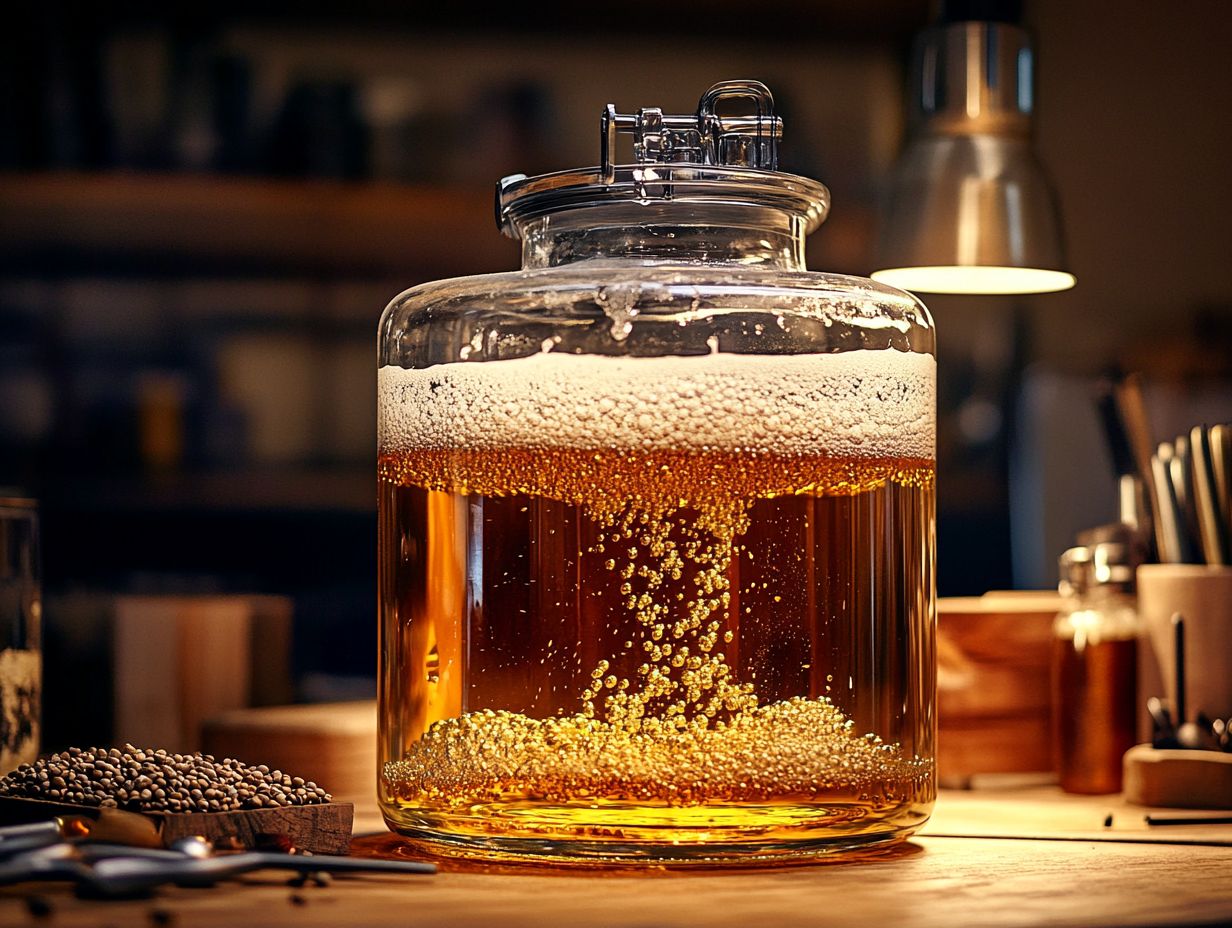
Monitoring the fermentation process is crucial for your brewing success, enabling you to track progress and make necessary adjustments along the way. By measuring specific gravity (a measure of the density of liquids) at regular intervals, you can accurately gauge how the fermentation is progressing and spot any potential issues before they escalate. Watching for visual cues, such as the formation of krausen (the foam that forms on top of fermenting beer), offers insights into the health of your yeast and the activity level during this vital stage.
Utilizing tools like hydrometers or refractometers gives you precise specific gravity readings, which are essential for determining sugar levels and knowing when fermentation is complete. You ll want to note the starting gravity and compare it to readings taken throughout the fermentation process, allowing you to see how effectively your yeast is transforming sugars into alcohol.
Pay attention to visual observations, such as bubble activity in the airlock and any changes in color or clarity; these details enhance your ability to assess the health of the fermentation. This meticulous monitoring ensures that any deviations can be swiftly addressed, ultimately leading to a successful and flavorful homebrew.
Understanding the fermentation stages and using proper brewing equipment is crucial in this process. Dive into the fascinating world of understanding the fermentation process in home brewing, and watch your homebrew transform into a delightful masterpiece!
What Are the Different Types of Fermentation Used in Home Brewing?
In the world of home brewing, you ll discover that different types of fermentation play a crucial role in crafting distinctive flavor profiles and characteristics in your beer, profoundly affecting the brewing styles you can produce. Maintaining proper yeast management and understanding the fermentation phases will help in creating a perfect brew.
You ll discover two fascinating types of yeast: top-fermenting yeast, which reigns supreme in ales, and bottom-fermenting yeast, the backbone of lagers. You may also explore spontaneous fermentation methods, like those utilized in Lambic beer production, which introduce a fascinating array of unique and complex flavors. Proper temperature control and pitch rates are essential in achieving the desired outcome.
This showcases the remarkable versatility and creativity that lies within the brewing process, inviting you to experiment and express your individual taste.
1. Top-Fermenting Yeast (Ale)
Top-fermenting yeast is your go-to choice for crafting ales, where those spirited yeast cells rise to the surface during fermentation, forming a charming krausen layer. This type of yeast thrives in warmer fermentation temperatures and adds robust flavor compounds that define a variety of ale styles, from crisp pale ales to rich stouts. The dynamic nature of top-fermenting yeast allows for the production of fruity and estery flavors, making ales truly distinctive and enjoyable alcoholic beverages.
Pay close attention to the health of your yeast. Unhealthy yeast can lead to unpleasant tastes and undesirable fermentation byproducts that can ruin your brew. As the fermentation process unfolds, aim for an optimal temperature range of 60 F to 75 F. This range significantly influences how the yeast metabolizes sugars and produces alcohol and carbon dioxide (CO2).
At these temperatures, the yeast’s capacity to develop rich flavors is enhanced, resulting in the delightful aromatic characteristics often celebrated in ales. Don t forget to add yeast nutrient to ensure a healthy fermentation.
The fascinating relationship between fermentation conditions, yeast vitality, and flavor synthesis highlights the artisanal craft of brewing. Each variable plays a crucial role in creating unique and enjoyable beer experiences, and you hold the reins to that remarkable journey. Consulting with a brewing consultant or referring to resources like MTF (Milk the Funk) can offer valuable insights. For a deeper understanding, explore fermentation in beer making and experiment with your brewing process to discover the nuances of top-fermenting yeast!
2. Bottom-Fermenting Yeast (Lager)
Bottom-fermenting yeast is absolutely essential for crafting lagers, as it settles at the bottom of the fermentation vessel, enabling a cooler fermentation process. This specific type of yeast thrives at lower temperatures, allowing it to grow slowly and deliver that clean, crisp finish you often associate with lagers.
Proper yeast management and understanding the fermentation techniques will ensure successful lager production. The dynamics of bottom-fermenting yeast create fewer esters and phenols, giving your lager a smooth and refined flavor profile that sets it apart from other brewing styles.
Monitoring specific gravity during fermentation will help you track the progress of your lager. Understanding the role of bottom-fermenting yeast is crucial if you want to perfect this style of beer.
Operating primarily in the temperature range of 45 F to 55 F (7 C to 13 C), this yeast significantly slows down fermentation, creating a more controlled environment. This reduced activity minimizes the risk of unpleasant tastes, ensuring that your resulting beer is not only drinkable but also refreshingly enjoyable.
The use of brewing techniques like secondary fermentation can further enhance the quality of your lagers. The unique characteristics of this yeast lead to beers that are remarkably clear and well-attenuated. Making sure to oxygenate your wort properly before pitching the yeast will help in achieving these desired outcomes.
In essence, the careful management of bottom-fermenting yeast during fermentation is critical in crafting the classic, crisp profile that defines lagers, making them a beloved choice among beer enthusiasts. Embrace the art of lager brewing, and enjoy the satisfaction of a perfectly crafted beer!
3. Spontaneous Fermentation (Lambic)
Spontaneous fermentation is a traditional brewing method that you ll find notably in the production of Lambic beers. Here, wild yeast and bacteria naturally inoculate the wort, crafting distinctive and complex flavors that tell a story. This fermentation process is steeped in a rich brewing history, highlighting the significance of environmental factors in beer production. Historical figures like Louis Pasteur and brewing pioneers from Carlsberg Laboratories have contributed to our understanding of these processes.
The unique flavor compounds created through this method are something that controlled fermentation simply cannot replicate. The character of Lambic beers, with their signature tartness and funk, truly showcases the artistry embedded in spontaneous fermentation. Understanding the brewing science behind these techniques can greatly enhance your brewing skills.
This brewing technique is intricately linked to the unique terroir of the Senne Valley in Belgium, where various strains of wild yeast, particularly Brettanomyces, flourish in the air. When you observe the open fermentation vessels, often exposed to the elements, you ll see how they invite the natural flora of the environment to mingle with the wort, creating a symbiotic relationship that significantly influences the flavor profile.
Factors like temperature, humidity, and seasonal changes play a vital role in shaping your final product, which means that Lambics can vary remarkably from batch to batch. This diversity results in a wide array of flavors in these beers, ranging from fruity and floral to sour and earthy, making each sip a delightful exploration of nature s bounty. Brewing styles like Hefeweizen, Wit, and saison also demonstrate the impact of environmental factors on flavor.
What Are the Factors That Affect Fermentation in Home Brewing?
In home brewing, several critical factors significantly influence fermentation, impacting both the efficiency of the process and the quality of the final beer. Proper yeast management, understanding fermentation dynamics, and using the right brewing techniques are essential for success.
Temperature control is paramount, as yeast activity can fluctuate dramatically with changes in temperature. Similarly, oxygen levels play a crucial role in maintaining yeast health and determining flavor outcomes. It s also essential to pay attention to pH levels, which can affect yeast performance, alongside the sugar content of the wort. Employing proper yeast culture and fermentation monitoring techniques can elevate the brewing process.
By carefully monitoring these elements, you can ensure optimal fermentation dynamics and elevate the quality of your brew.
1. Temperature
Temperature plays a crucial role in your brewing endeavors, significantly impacting yeast growth and activity during fermentation. Each yeast strain boasts an ideal fermentation temperature range that optimizes its performance, while any deviations can lead to unwanted byproducts and fermentation challenges. By understanding how temperature influences yeast dynamics, you can refine your brewing processes to achieve the flavor profiles you desire in your beer. Employing specific fermentation techniques can help in maintaining the desired fermentation temperature ranges.
When you keep the fermentation temperature within the optimal range, yeast flourishes and produces distinctive flavors that add layers of complexity to the final product. For example, higher temperatures tend to enhance fruity esters, while cooler conditions result in more subdued flavors. Ensuring proper yeast fermentation and adding adequate malt and maltose will contribute significantly to your beer’s flavor.
However, if temperatures soar too high, you risk stressing the yeast, which can lead to off-flavors and stalled fermentation. This is why effective temperature control is essential; it ensures consistent yeast activity throughout the brewing process.
By closely monitoring temperature fluctuations, you can prevent potential fermentation issues and craft beers that beautifully express your intended taste profiles.
2. Oxygen Levels
Understanding oxygen levels is your secret weapon in brewing the perfect beer! Oxygen levels are absolutely critical in the fermentation process, especially in those early stages when yeast craves a bit of oxygen to thrive and multiply. However, be cautious excessive exposure to oxygen later on can lead to off-flavors that compromise the quality of your beer.
It’s essential to manage oxygen levels carefully throughout fermentation to ensure your brewing endeavors yield the finest results. Proper oxygenation techniques can make a significant difference in yeast health and flavor outcomes.
Grasping the delicate balance of oxygen is fundamental for any brewer looking to craft exceptional beverages. During the aerobic phase of fermentation, your yeast relies on oxygen for yeast growth, which lays the groundwork for a vigorous fermentation. But once those anaerobic conditions kick in, introducing oxygen becomes a risky move. It can lead to oxidation, causing undesirable flavors like cardboard notes or a stale character. Managing fermentation dynamics and using proper brewing techniques helps maintain this balance.
To maintain optimal oxygen levels, consider adopting some best practices, such as:
- Purging fermentation vessels with carbon dioxide before use
- Utilizing oxygen-scavenging caps
- Ensuring thorough sanitation to minimize oxygen uptake
By implementing these strategies, you can effectively protect the health of your yeast and elevate the flavor profile of your finished product.
3. pH Levels
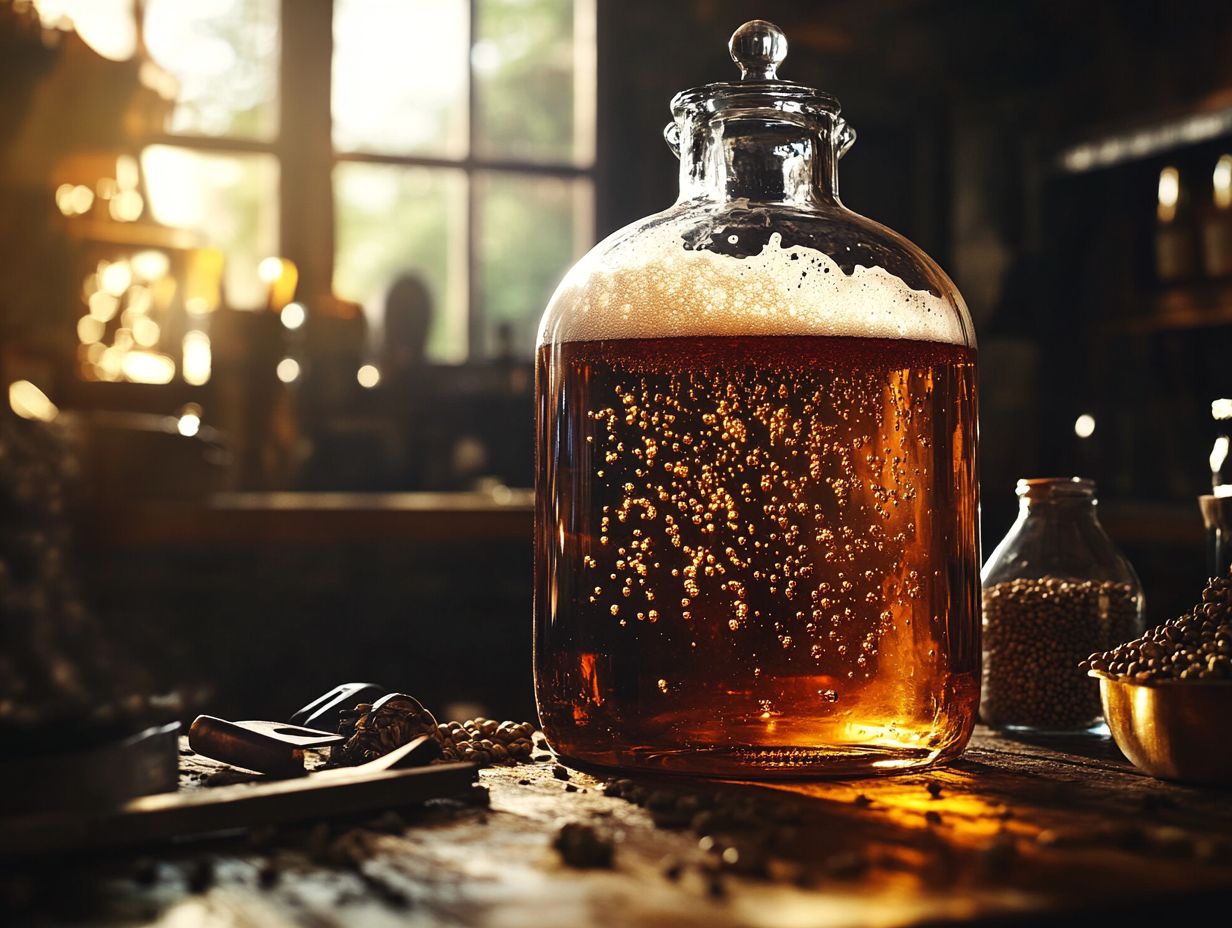
pH levels play a crucial role in fermentation, significantly affecting yeast performance and cell activity. By maintaining an optimal pH range, you ensure that your yeast remains active and healthy, which not only promotes efficient fermentation but also prevents the growth of unwanted organisms.
Monitoring and adjusting pH levels throughout the brewing process can greatly enhance fermentation health and elevate the quality of your final beer. Consulting resources like the Local Beer Blog or experts like David Ackley can provide valuable guidance on maintaining proper pH levels.
In the realm of brewing, the ideal pH typically sits between 4.0 and 5.0, a range that fosters optimal yeast activity. If the pH strays from this sweet spot, you risk sluggish fermentation or off-flavors that can compromise the quality of your brew.
The addition of nitrogen and other nutrients can help maintain the desired pH levels and healthy yeast growth. It s essential for you to regularly check pH levels, especially during the mashing and fermentation stages, using reliable tools like pH meters or color indicators.
Don t wait should your readings fall outside the desired range, adjust with food-grade acids or bases to restore balance. By prioritizing pH management, you set the stage for a more predictable fermentation outcome, allowing you to achieve the delightful flavor profiles you envisioned for your brew.
4. Sugar Content
The sugar content in your wort is a key driver of fermentation, acting as the essential fuel for yeast to produce alcohol and carbon dioxide. The types of sugars present like maltose and other fermentable sugars can significantly influence both the fermentation dynamics and the final flavor profile of your beer.
Therefore, grasping the nuances of sugar content and composition is vital for brewers like you who aspire to achieve specific fermentation outcomes. Different sugars, such as glucose, fructose, and sucrose, are metabolized by yeast at distinct rates, leading to unique fermentation scenarios.
For example, yeast has a particular affinity for glucose due to its straightforward fermentability, while maltose demands a more intricate metabolic pathway. This difference not only affects yeast activity but also shapes the production of various flavor compounds and esters, ultimately enhancing your beer’s aroma and taste.
Regarding sugar concentrations, higher levels can elevate alcohol content, while lower sugar inputs might result in more residual sweetness, creating a well-rounded flavor profile. Therefore, as a brewer, it s essential for you to carefully curate the sugar content to align perfectly with your desired beer style.
Now that you understand the importance of sugar content, take a moment to evaluate your own wort’s sugar levels!
How Can You Tell When Fermentation is Complete?
Determining when fermentation is complete is an essential skill for any brewer, as it guarantees that your beer reaches its optimal flavor and quality before you proceed to bottling or kegging.
This article will explore three key methods for determining fermentation completion: specific gravity readings, visual cues, and taste testing. Each method provides vital information to help ensure the success of your brewing process.
1. Specific Gravity Readings
Take specific gravity readings over several days. If the gravity remains stable, it’s a strong indication that fermentation has come to an end. Specific gravity readings serve as an important tool in your journey through fermentation, enabling you to meticulously track the transformation of sugars into alcohol over time.
By measuring specific gravity at various stages, you can pinpoint when fermentation is approaching completion; stable readings indicate that yeast activity has slowed or halted entirely. This practice helps you assess the health of the fermentation process and guides your decisions on when to bottle or keg the finished product.
To take a specific gravity reading, simply draw a small sample of the fermenting liquid and place it in a hydrometer, which will float at a level that reflects the liquid’s density. Each reading provides valuable insight into the remaining sugars; a high specific gravity suggests that fermentation is still in full swing, while a lower reading signifies that much of the sugar has been consumed.
Grasping these measurements gives you the power to determine the optimal timing for introducing fining agents or additional flavorings, ultimately enhancing the overall quality of your brew. By diligently monitoring specific gravity throughout the fermentation process, you can ensure consistency in alcohol content, guaranteeing that your final product meets the desired specifications.
2. Visual Cues
Visual cues serve as important signs in assessing the fermentation process and determining its completion, giving you important information about yeast activity and health. When you notice krausen, which is the foam that forms on the surface of your beer during fermentation, it typically signifies that active fermentation is in full swing. Conversely, its disappearance might indicate that fermentation is winding down.
By observing changes in the beer’s clarity and the presence of sediment, you can gain valuable information about the fermentation status. Keep an eye on the bubbles rising through the liquid this is a clear sign of carbon dioxide production. Vigorous bubbling indicates that fermentation is ongoing, while a decrease in activity may suggest it’s approaching completion.
The color of your beer may shift as fermentation progresses, reflecting the metabolic activities of the yeast. Additionally, monitoring the final gravity reading is crucial; when it stabilizes over a few days, it confirms that fermentation has come to a halt. By attentively watching these visual indicators, you can make well-informed decisions about the next steps in your brewing process, ultimately ensuring a high-quality final product.
3. Taste Testing
Taste testing is a key part of the fermentation process and an essential method for assessing fermentation completion and the overall flavor profile of your beer. This process allows you to detect any off-flavors or undesirable characteristics that might arise. By sampling your beer at various stages of fermentation, you can evaluate the development of flavors and determine whether further fermentation is necessary to achieve the perfect outcome.
Understanding how tastes evolve during fermentation provides you with critical insights into yeast activity and sugar consumption, both of which play pivotal roles in enhancing flavor. In the initial stages, you might encounter raw, unrefined flavors, but as you continue sampling, you ll notice complexity and depth emerging as fermentation progresses.
This incremental tasting allows you to observe the transformation of aromas and tastes from sweet to bitter enabling you to make adjustments that align with your vision for the final product. Ultimately, these evaluations shed light on the vital relationship between fermentation dynamics and flavor development, giving you the power to craft beer that meets your high standards.
Start monitoring your fermentation using these methods, and elevate your brewing game!
What Are Some Common Problems That Can Occur During Fermentation?
Common issues during fermentation can greatly affect the quality of your final beer, presenting challenges that every homebrewer should recognize.
A stuck fermentation may occur when the yeast becomes inactive, halting the conversion of sugars into alcohol and leaving you with an incomplete product.
Infections from unwanted microorganisms can spoil your brew, resulting in off-flavors and unpleasant aromas. This highlights the importance of maintaining excellent yeast health and hygiene throughout your brewing process to ensure a successful outcome.
1. Stuck Fermentation
Stuck fermentation happens when yeast fails to finish its fermentation process. This leads to higher-than-expected specific gravity readings and an unfinished beer. Various factors can cause this issue, such as insufficient yeast health, inadequate oxygen levels, or less-than-ideal fermentation temperatures.
Recognizing the signs of stuck fermentation and taking corrective measures is vital for you as a brewer. It s crucial if you want to salvage your beer and achieve that perfect flavor profile.
This situation can result in off-flavors and altered aromas. Your final product may stray far from your original vision. Watch for signs of stuck fermentation. A lack of bubbling in the airlock and constant specific gravity readings are indicators.
To address this problem, start by assessing your yeast health. Ensure you’ve pitched enough active cells and managed fermentation conditions effectively. Properly aerating the wort, maintaining optimal temperatures, and adding nutrients can really breathe life back into struggling yeast.
If fermentation has already stalled, consider re-pitching with fresh yeast or gently swirling the fermenter to re-suspend the yeast. This could be just the boost your fermentation needs to get back on track.
2. Infection
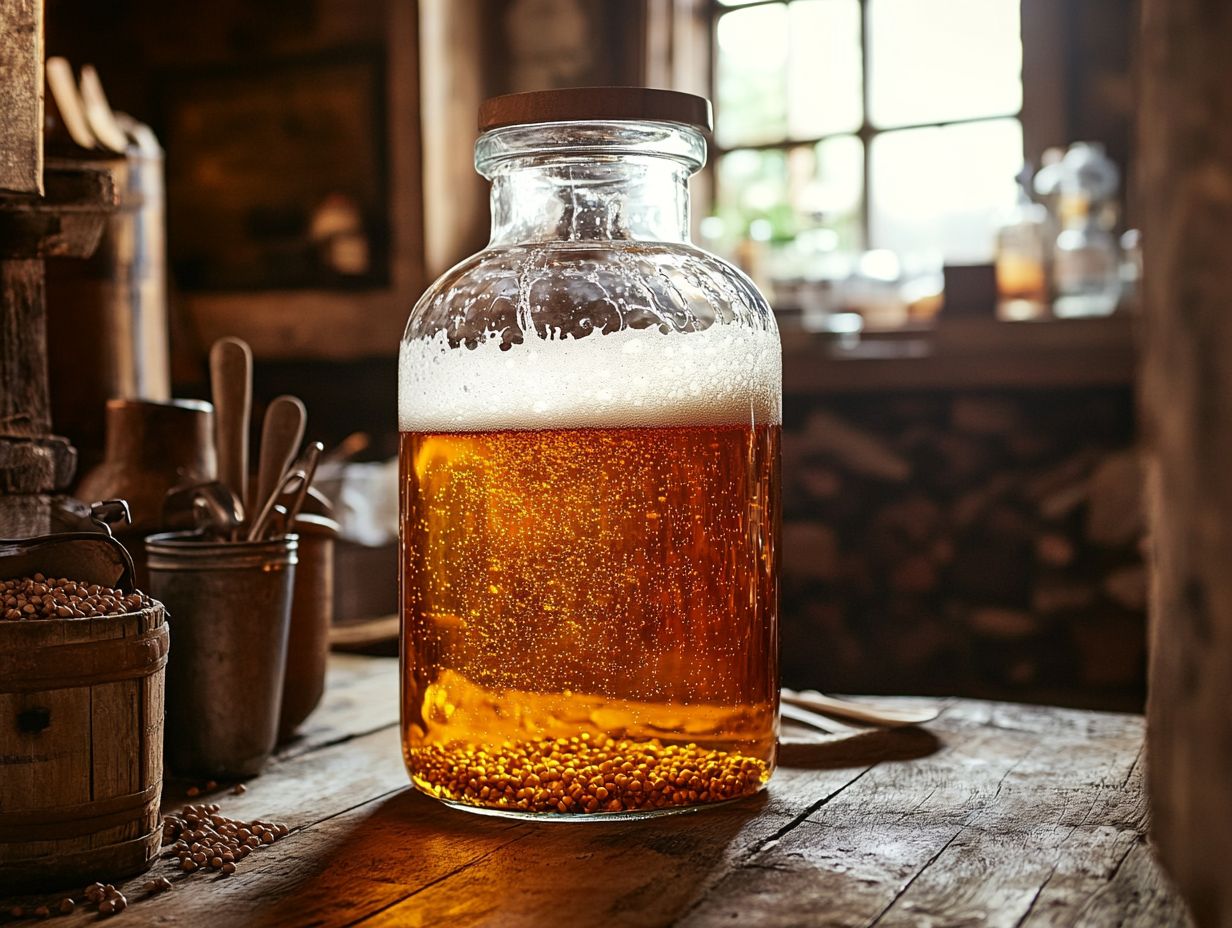
Infection is a pressing concern in home brewing, occurring when unwanted microorganisms, like bacteria or wild yeast, infiltrate the fermentation process. Such infections can lead to off-flavors and spoilage, profoundly affecting the quality and drinkability of your beer.
To protect your precious brew, follow strict sanitation protocols. Ensure all equipment is sanitized and monitor yeast health throughout the brewing process.
The presence of harmful microbes can impart sour or vinegar-like flavors, ruining even the most meticulously crafted recipes. Adhere to rigorous sanitation protocols by employing food-grade sanitizers on all equipment, bottles, and surfaces.
Controlling fermentation temperatures is essential. It fosters an environment where your preferred yeast can thrive while keeping potential contaminants at bay. Also, monitor your fermentation vessels for any unusual cloudiness or off-odors, as these can signal contamination.
By implementing these preventative measures and utilizing proper yeast management, you can preserve the quality of your final product, ensuring a truly enjoyable home-brewed experience.
Take these steps today to ensure your homebrew is nothing short of exceptional!
3. Off-Flavors
Off-flavors during fermentation can stem from a variety of factors, such as yeast stress, fermentation temperature, and the notorious presence of diacetyl the culprit behind those unwanted buttery notes in your beer. It s crucial for you to identify and address the sources of these off-flavors to ensure that the final product meets your quality standards and brings joy to those who savor it. By closely monitoring fermentation conditions, including oxygen levels and the health of your yeast, you can significantly reduce the risk of off-flavors and elevate the overall flavor profile of your brew.
A solid understanding of the fermentation process is vital, as it plays a key role in the production of any unwanted flavor compounds. For example, if your fermentation temperature climbs too high, you may inadvertently increase the production of fusel alcohols, resulting in harsh, solvent-like flavors that are far from desirable. Additionally, improper pitch rates can stress your yeast, leading to the formation of esters that may come across as excessively fruity or downright unpleasant.
To tackle these challenges, maintain optimal temperature ranges, ensure your yeast populations are healthy, and adhere to good fermentation hygiene practices. By doing so, you ll create an environment that allows for a cleaner, more appealing flavor profile in your brews.
Frequently Asked Questions
What is fermentation and why is it important in home brewing?
Fermentation is a process in which yeast converts sugars, such as maltose, into alcohol and carbon dioxide, resulting in the creation of beer. It is a crucial step in home brewing as it not only produces alcohol, but also adds flavor, aroma, and carbonation to the final product.
What type of yeast is used in home brewing fermentation?
Ale and lager yeasts are the most commonly used types in home brewing. Ale yeast, also known as top-fermenting yeast, ferments at warmer temperatures and produces a fruity and complex flavor. Lager yeast, on the other hand, ferments at colder temperatures and creates a crisp and clean taste. Using the right fermentation techniques can enhance these characteristics.
How long does fermentation typically take in home brewing?
The length of fermentation can vary depending on factors such as the type of yeast used, the temperature, and the type of beer being brewed. Generally, fermentation can take anywhere from 1-3 weeks, with some stronger beers requiring longer fermentation times. Proper fermentation monitoring can help in achieving the best results.
Can I control the flavor of my beer through fermentation?
Yes, the temperature and duration of fermentation can greatly influence the flavor profile of your beer. For example, a warmer fermentation can lead to more esters and a fruitier taste, while a cooler fermentation can result in a cleaner and crisper flavor. Effective temperature control is essential for managing these aspects.
Do I need any special equipment for fermentation in home brewing?
Yes, you will need a fermentation vessel such as a glass carboy or plastic bucket with an airlock, as well as a thermometer to monitor the temperature. It is also recommended to have a hydrometer to measure the specific gravity of the beer during fermentation. Additional brewing equipment like a stir plate can aid in yeast growth and overall fermentation health.
Is it necessary to transfer the beer during fermentation?
Transferring, also known as racking, is not necessary but can be beneficial for clarifying the beer and removing any sediment. It also allows for the beer to age and develop more complex flavors. However, be careful not to introduce oxygen during the transfer process as it can affect the taste of the beer. This step can be part of secondary fermentation.

